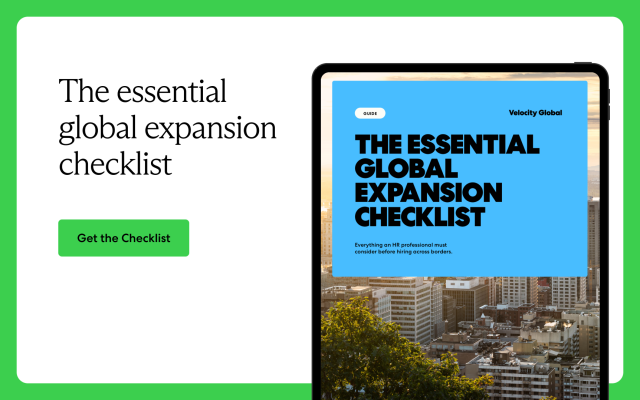If your business has hit its stride domestically, you may be considering expanding overseas. Global expansion promises many opportunities, from accessing a larger consumer base to diversifying revenue streams. Still, this move comes with unique challenges.
Before entering a new market, organizations must assess market conditions and ensure their HR and finance teams can manage a distributed workforce. By preparing risk mitigation strategies and contingency plans, companies can drastically increase their chances of success abroad and avoid major headaches as they expand their global footprint.
Read on to discover 10 risks of expanding a business internationally. Plus, find useful tips on assessing markets and reducing risk so you can expand overseas with ease.
10 risks of expanding a business internationally
Risk is an unavoidable aspect of any business expansion. Yet, the risks associated with global expansion are far greater than those of regional or national growth.
When entering new markets, global companies must navigate various complexities, including political instability, economic volatility, intellectual property (IP) protection, regulatory compliance, and more.
We discuss the 10 primary risks of expanding a business internationally in detail below.
1. Cultural and social differences
Navigating cultural and social differences between your domestic and target markets is critical for your success as you expand overseas.
When operating internationally, you’ll interact with local business partners in your target market and develop a globally distributed team. You may need to adjust your communication style to avoid confusion and faux pas while communicating with local teammates and business partners. You’ll also need to assess how the local consumer base will perceive your brand.
Communication with local partners
Consider cultural standards, business norms, and ethical practices to guide your communication with local business partners and avoid misunderstandings. This will facilitate strong, lasting relationships with local players that will be critical for long-term growth and sustainability.
Your communication strategy should also account for potential language barriers. Language barriers make it difficult to effectively market your product and communicate with customers and partners. Unless you expand into a bilingual or English-speaking market, you may need to hire staff fluent in the local language or use translation services.
Intra-organizational communication
Hiring international talent can bring inspiration, perspective, and a unique flare to any team. To reap the benefits of a diverse workforce, remember that different cultures approach everything from business etiquette to product design differently.
Develop a supportive atmosphere for intra-organizational communication that welcomes everyone’s contribution and ensures each team member feels comfortable and supported at work.
Brand adaptation
Different cultures perceive brands and images differently. Adjust your marketing strategy and brand image to resonate with the local audience, and adapt your product or service offering to meet the needs of the local consumer base.
As you familiarize yourself with the local culture, determine how your organization can adapt to cultural and social differences while staying true to your business. This will be critical for sustainable, long-term growth.
2. Political instability
Understanding the local consumer base, properly positioning a product, and developing a sound market entry strategy are key to ensuring long-term success as you expand globally. Still, overlooking political volatility in your target market can render these efforts mute.
Consider international supply chains, for instance. Political upheaval often disrupts international supply chains and creates a rippling effect across the global marketplace.
The conflict in Ukraine is a key example. Before the conflict began, fifteen African countries imported over 50% of their wheat products from Ukraine and Russia. However, the Black Sea blockade in 2022 drove wheat prices up and triggered a 30 million-ton grain shortage across the entire African continent.
Political instability can arise from any of the following scenarios:
- Regime change
- Political upheaval
- Civil unrest
- Unstable government policies
- Geopolitical conflicts
The first step to mitigating political risk is understanding the local political environment. Before selecting a target market, assess various trends, such as patterns of civil unrest, regime instability, and geopolitical conflicts.
Such events can drastically impact the local business environment, leading to regulatory changes, currency fluctuations, or asset expropriation. If possible, communicate with local government leaders and organizations to gain insight and determine if a market threatens your global sourcing strategy.
3. Economic volatility
Global companies must assess the economic volatility of their potential target markets before expanding internationally. Economic conditions differ widely between countries, and factors like inflation, unemployment, currency devaluation, and interest rates can drastically impact growth potential.
For instance, countries with high inflation face rising interest rates, which increases borrowing costs and limits business opportunities for growth and development. High interest rates can also reduce investor interest and impact the value of the national currency. Should a recession occur, local businesses can lose access to credit. Collections become slow, sales decline, and many businesses can fall into bankruptcy.
However, recessions impact organizations differently depending on company size and structure. For instance, a small consulting firm may experience cashflow issues as clients delay invoice payments, while a large Fortune 500 company can survive by cutting jobs and renegotiating terms with suppliers.
Countries with steady economies, strong consumer spending, and growing middle classes are promising options for expansion. Determine your target market’s economic viability and prepare for contingencies by assessing trends and reviewing economic indicators, such as GDP, inflation, and exchange rates.
4. Currency exchange rate risks
Currency exchange rates fluctuate regularly, posing ongoing challenges for companies with a global footprint. Establishing a risk mitigation plan for currency fluctuations is critical for achieving long-term, stable growth.
Volatile currency exchange rates can lead to short-term transactional losses and long-term operating exposures that can drastically devalue a subsidiary or its entire parent company over time.
For instance, exchange rate volatility impacts your ability to make or receive payments denominated in foreign currency, which can hurt or enhance profitability in the short to mid-term. Currency volatility also impacts your financial statements, including the value of equities, assets, and liabilities, which can further exaggerate losses and gains.
Exchange rate fluctuations can also cause long-term operational losses. Consider a global company headquartered in the U.S. with multiple foreign subsidiaries, for instance. A strengthening US dollar can reduce long-term profitability as profits from overseas sales are smaller once converted into dollars.
When considering potential target markets, consider how currency exchange rates will impact profitability and prospects for stable growth, and always prepare strategies to mitigate risk. For example, spreading production facilities and end-product markets across multiple countries can help mitigate long-term losses.
5. Market competition
Entering new markets often means facing local and international competitors. Understanding the competitive landscape and adapting marketing, positioning, and pricing strategies is crucial for success.
Assessing the competition in your target market involves many factors we’ve already discussed, including cultural norms, language barriers, and consumer needs. However, you’ll also need to consider regulatory obstacles and logistical challenges to remain competitive, such as tariffs, supply chain bottlenecks, and distribution channels.
Evaluate market saturation and identify your main competitors. Determine their competitive advantages, evaluate their brand reputation, and clarify how you can strategically position your product or service to gain a footing in your target market.
You’ll also want to consider market trends, such as consumer behavior shifts and technology trends, and assess pricing strategies and distribution factors.
Can you competitively price your product or service in the local market? Will the availability and efficiency of your distribution channels facilitate competitive pricing? Can you leverage existing distribution networks or do you need to establish new ones?
Market competition varies worldwide. For instance, an unsaturated market may offer more growth potential than a highly competitive one. However, a competitive market may offer other valuable opportunities, such as more well-established distribution channels.
6. Intellectual property (IP) concerns
One of the biggest challenges global companies face when operating internationally is protecting their IP across multiple markets. IP includes patents, copyrights, trademarks, trade secrets, and any intangible asset distinguishing a business from its competition. IP laws and regulations vary worldwide, creating a major risk for global companies.
IP protection is critical for nearly any business. Organizations with innovative manufacturing processes and designs must protect their IP to prevent foreign entities from imitating their product. Fashion and media-based companies must also protect their copyrights and trademarks to maintain brand identity and reputation.
Still, some businesses are more vulnerable to infringements than others. In many cases, companies with the most to gain from international expansion have the most to lose from IP infringements. For instance, organizations with pioneering technology solutions must protect their trade secrets to remain competitive in new markets.
Each country has varying IP laws and regulations, and navigating legal frameworks worldwide can be daunting. Consider taking the following steps to safeguard your IP in international markets:
- Conduct an IP audit to understand the value of your assets, clarify vulnerabilities, and identify opportunities for protection
- Catalog all IP assets, such as artwork, logos, brand names, and designs, to establish a comprehensive overview of what needs protection
- Consider patents, trademarks, copyrights, or other means to protect your assets, depending on their nature and vulnerability
- Collaborate with local experts and legal partners to gain insights into local regulations and help navigate the legal landscape effectively
Remember, there’s no one-size-fits-all approach to IP protection. Global companies must develop strategies tailored to their specific assets, industries, and target markets.
As you expand, your IP portfolio may evolve. Regularly auditing the changing landscape and adjusting your strategy is critical for mitigating risk.
7. Technology and infrastructure challenges
Infrastructure quality can hinder or enhance business operations, depending on which resources you rely on.
Evaluating digital and physical infrastructure is a critical aspect of market assessment. Companies that rely on transportation should check roads, railways, and airports in their target market—assess their quality, and determine whether or not local authorities regularly maintain them.
A stable and quick internet connection is critical for almost every business. However, technology-dependent organizations, such as those that use telecommunication, e-commerce, or cloud-based solutions, should choose a market with a robust digital infrastructure that supports access to these services.
Regardless of the infrastructure your company relies on, prepare contingency plans. For instance, assess the potential for network failures in your target market and install backup systems. Or, protect your operations from supply chain disruptions by building relationships with suppliers in different markets.
8. Human resource management
Managing an international workforce involves unique challenges for HR teams. Global HR involves many of the same processes your HR team already manages domestically but on a much larger scale.
Plus, international HR teams must take on entirely new processes, such as onboarding remote employees, running compliant global payroll, and offering ongoing support to teams in different time zones in multiple languages.
Below, we list the most common challenges HR teams face when hiring, paying, and managing an international workforce:
- Limited resources. Global expansion involves high administrative and financial costs, such as greater workloads and investments in physical infrastructure. These burdens can draw capital away from supporting employees.
- Talent and opportunity loss. Inefficiencies with global processes, such as navigating immigration and running global payroll, can lead to operational disruptions and employee churn.
- Employee cost calculations. HR and finance must consider talent-related risks, such as total employee cost and ROI on employee cost, to accurately predict profitability throughout the expansion.
- Inefficient processes. HR teams need global workforce management solutions to support international teams. Without the right tools, companies risk noncompliance penalties, operational delays, budgeting constraints, and employee churn.
Enlisting an experienced HR team and equipping them with the resources needed to build and manage a distributed team is critical for long-term success as you expand overseas.
9. Financial considerations
Global expansion is expensive, and financial considerations are critical at every stage—from initial funding and upfront investments to sustaining operations until you become profitable.
Before entering a new market, consider every aspect of your financial planning, from market research and legal fees to product marketing and logistics costs.
Some of the most common challenges finance teams face when undergoing global expansion include the following:
- Risk mitigation. Lacking knowledge of target market dynamics makes initial scaling efforts extremely risky.
- Limited resources. Without enough historical info, finance teams can’t build predictive models and develop scenario analysis capabilities to forecast costs.
- Cost balancing. Finance teams must account for every cost associated with the expansion. For instance, they must balance talent costs with overall expansion costs.
- Opportunity loss. Undesirable results at the beginning of your expansion can prevent you from delivering on commitments to investors, board members, and shareholders, leading to opportunity losses.
Global companies must be in a strong financial position and have the necessary resources to accurately calculate costs, execute their growth strategy, and reach complex growth milestones as they enter new markets.
10. Regulatory and legal challenges
One of the most complex aspects of global expansion is ensuring international compliance. Navigating foreign labor laws, regulations, and standards can be complex, and failing to comply with local regulations can lead to legal issues, fines, or even business closures.
Global companies must practice due diligence to mitigate risk. This includes evaluating the stability of their host country’s legal system, researching relevant laws, factoring noncompliance risks into their expansion strategy, and identifying mechanisms for dispute resolution. They must also comply with reporting requirements at home.
Some of the most important steps global companies can take to mitigate compliance risks when expanding internationally include the following:
- Evaluate the local regulatory environment. Is the local legal system in your target market stable and predictable? Consider factors like transparency, consistency, corruption, bureaucracy, and red tape.
- Identify relevant laws. Identify specific regulations that apply to your operations, such as labor, tax, intellectual property, import, export, and environmental laws.
- Calculate costs and risks. Calculate the cost of ensuring compliance and factor potential penalties into your budget.
- Assess dispute resolution mechanisms. Identify dispute resolution mechanisms in your target market, such as court systems and arbitration. Consider their effectiveness, efficiency, enforceability, and cost.
Noncompliance can result in fines, litigation, and slower speed-to-market. Familiarize yourself with local regulatory frameworks and develop a contingency plan to avoid major headaches and setbacks. Or, partner with a local legal expert to ensure compliance on your behalf.
Learn more: International Business Law: Understanding the Legal Aspects of Doing Business Abroad
Lower your risk by partnering with a global expansion expert
Despite its benefits, going global involves serious risk and requires thorough planning. Eliminate the risk and unlock your growth potential by partnering with an international expansion expert like Velocity Global.
Velocity Global’s employer of record (EOR) solution simplifies overseas expansion for companies of all sizes. An EOR is a third-party entity with global infrastructure and international legal expertise that makes it easy for organizations to expand globally without establishing legal entities or worrying about risk mitigation.
Whether you’re in the initial planning stages or expanding an existing global footprint, an EOR partner like Velocity Global can provide strategic market assessments, regulatory considerations, and cultural insights to help you mitigate risk as you enter new markets.
Plus, we streamline global HR by handling every aspect of workforce management on your behalf. This includes hiring, onboarding, immigration, compliance, running global payroll, administering global benefits, and offering ongoing support to your distributed team in their native language.
By partnering with Velocity Global, you can eliminate the risk of doing business overseas and quickly and compliantly expand operations to over 185 countries without skipping a beat.
Download our essential global expansion checklist that offers key tips on developing your global strategy, conducting market research, hiring global talent, and mitigating risk along the way:

Discover your path to international success with Velocity Global
Contact Velocity Global today to learn how we can help you simplify market navigation, international workforce expansion, and risk mitigation so you can expand globally with ease.



